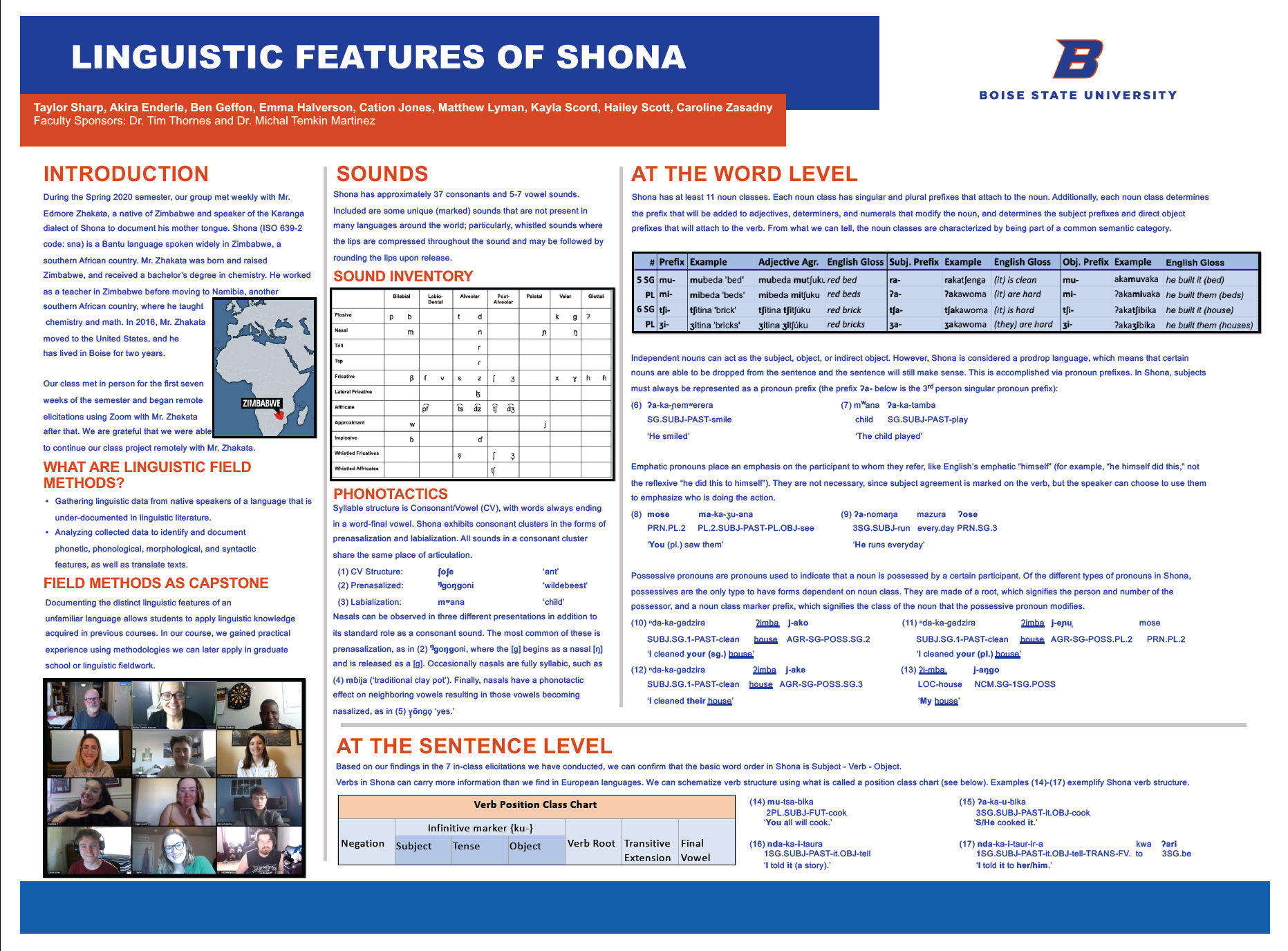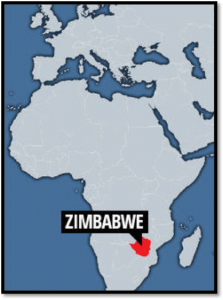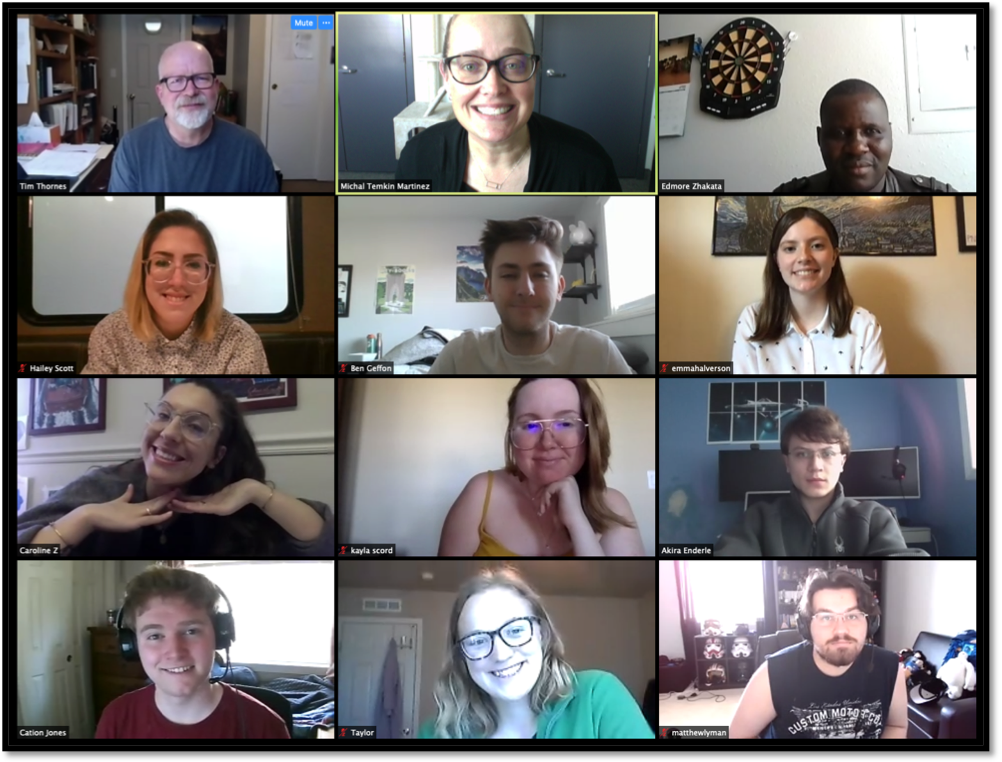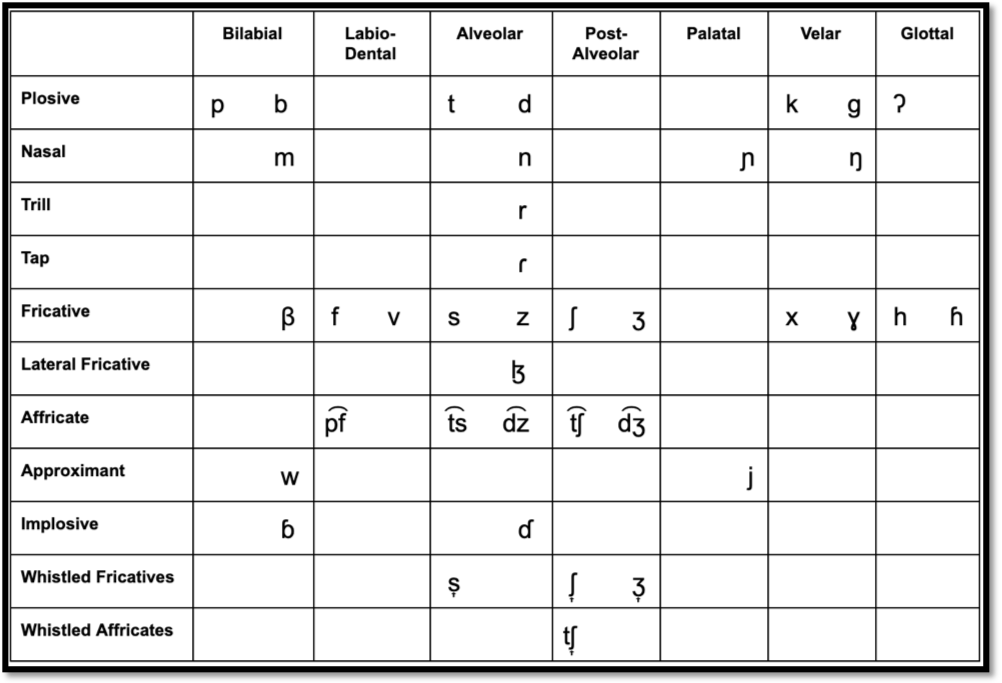Taylor Sharp, Akira Enderle, Ben Geffon, Emma Halverson, Cation Jones, Matthew Lyman, Kayla Scord, Hailey Scott, Caroline Zasadny, Dr. Michal Temkin Martinez, Dr. Tim Thornes

Introduction

During the Spring 2020 semester, our group met weekly with Mr. Edmore Zhakata, a native of Zimbabwe and speaker of the Karanga dialect of Shona to document his mother tongue. Shona (ISO 639-2 code: sna) is a Bantu language spoken widely in Zimbabwe, a southern African country. Mr. Zhakata was born and raised Zimbabwe, and received a bachelor’s degree in chemistry. He worked as a teacher in Zimbabwe before moving to Namibia, another southern African country, where he taught chemistry and math. In 2016, Mr. Zhakata moved to the United States, and he has lived in Boise for two years.
Our class met in person for the first seven weeks of the semester and began remote elicitations using Zoom with Mr. Zhakata after that. We are grateful that we were able to continue our class project remotely with Mr. Zhakata.
What are linguistic field methods
- Gathering linguistic data from native speakers of a language that is under-documented in linguistic literature.
- Analyzing collected data to identify and document
phonetic, phonological, morphological, and syntactic
features, as well as translate texts.
Field Methods as Capstone
Documenting the distinct linguistic features of an unfamiliar language allows students to apply linguistic knowledge acquired in previous courses. In our course, we gained practical experience using methodologies we can later apply in graduate school or linguistic fieldwork.

Sounds
Shona has approximately 37 consonants and 5-7 vowel sounds. Included are some unique (marked) sounds that are not present in many languages around the world; particularly, whistled sounds where the lips are compressed throughout the sound and may be followed by rounding the lips upon release.
Sound Inventory

Phonotactics
Syllable structure is Consonant/Vowel (CV), with words always ending in a word-final vowel. Shona exhibits consonant clusters in the forms of prenasalization and labialization. All sounds in a consonant cluster share the same place of articulation.
(1) CV Structure: ʃ̞oʃ̞e ‘ant’
(2) Prenasalized: ŋgoŋgoni ‘wildebeest’
(3) Labialization: mʷana ‘child’
Nasals can be observed in three different presentations in addition to its standard role as a consonant sound. The most common of these is prenasalization, as in (2) ŋgoŋgoni, where the [g] begins as a nasal [ŋ] and is released as a [g]. Occasionally nasals are fully syllabic, such as (4) m̩ɓija (‘traditional clay pot’). Finally, nasals have a phonotactic effect on neighboring vowels resulting in those vowels becoming nasalized, as in (5) ɣ̥õngo̥ ‘yes.’
At the Word Level
Shona has at least 11 noun classes. Each noun class has singular and plural prefixes that attach to the noun. Additionally, each noun class determines the prefix that will be added to adjectives, determiners, and numerals that modify the noun, and determines the subject prefixes and direct object prefixes that will attach to the verb. From what we can tell, the noun classes are characterized by being part of a common semantic category.
| # | Prefix | Example | Adjective Agr. | English Gloss | Subj. Prefix | Example | English Gloss | Obj. Prefix | Example | English Gloss |
|---|---|---|---|---|---|---|---|---|---|---|
| 5 SG | mu- | mubeda 'bed' | mubeda mutʃuku | red bed | ra- | rakatʃenga | (it) is clean | mu- | akamuvaka | he built it (bed) |
| PL | mi- | mibeda 'beds' | mibeda mitʃuku | red beds | ʔa- | ʔakawoma | (it) are hard | mi- | ʔakamivaka | he built them (beds) |
| 6 SG | tʃi- | tʃitina 'brick' | tʃitina tʃitʃúku | red brick | tʃa- | tʃakawoma | (it) is hard | tʃi- | ʔakatʃibika | he built it (house) |
| PL | ʒi- | ʒitina 'bricks' | ʒitina ʒitʃúku | red bricks | ʒa- | ʒakawoma | (they) are hard | ʒi- | ʔakaʒibika | he built them (houses) |
Independent nouns can act as the subject, object, or indirect object. However, Shona is considered a prodrop language, which means that certain nouns are able to be dropped from the sentence and the sentence will still make sense. This is accomplished via pronoun prefixes. In Shona, subjects must always be represented as a pronoun prefix (the prefix ʔa- below is the 3rd person singular pronoun prefix):
(6) ʔa-ka-ɲemʷereɾa
SG.SUBJ-PAST-smile
‘He smiled’
(7) mwana ʔa-ka-tamba
child SG.SUBJ-PAST-play
‘The child played’
Emphatic pronouns place an emphasis on the participant to whom they refer, like English’s emphatic “himself” (for example, “he himself did this,” not the reflexive “he did this to himself”). They are not necessary, since subject agreement is marked on the verb, but the speaker can choose to use them to emphasize who is doing the action.
(8) mose ma-ka-ʒ͎u-ana
PRN.PL.2 PL.2.SUBJ-PAST-PL.OBJ-see
‘You (pl.) saw them’
(9) ʔa-nomaŋa mazura ʔose
3SG.SUBJ-run every.day PRN.SG.3
‘He runs everyday’
Possessive pronouns are pronouns used to indicate that a noun is possessed by a certain participant. Of the different types of pronouns in Shona, possessives are the only type to have forms dependent on noun class. They are made of a root, which signifies the person and number of the possessor, and a noun class marker prefix, which signifies the class of the noun that the possessive pronoun modifies.
(10) ⁿda-ka-gadzira ʔimba j-ako
SUBJ.SG.1-PAST-clean house AGR-SG-POSS.SG.2
‘I cleaned your (sg.) house’
(11) ⁿda-ka-gadzira ʔimba j-eɲu̥ mose
SUBJ.SG.1-PAST-clean house AGR-SG-POSS.PL.2 PRN.PL.2
‘I cleaned your (pl.) house’
(12) ⁿda-ka-gadzira ʔimba j-ake
SUBJ.SG.1-PAST-clean house AGR-SG-POSS.SG.3
‘I cleaned their house’
(13) ʔi-mba j-aŋgo
LOC-house NCM.SG-1SG.POSS
‘My house’
At the Sentence Level
Based on our findings in the 7 in-class elicitations we have conducted, we can confirm that the basic word order in Shona is Subject – Verb – Object. Verbs in Shona can carry more information than we find in European languages. We can schematize verb structure using what is called a position class chart (see below).

Examples (14)-(17) exemplify Shona verb structure.
(14) mu-tsa-bika
2PL.SUBJ-FUT-cook
‘You all will cook.’
(15) a-ka-u-bika
3SG.SUBJ-PAST-it.OBJ-cook
‘S/He cooked it.’
(16) nda-ka-i-taura
1SG.SUBJ-PAST-it.OBJ-tell
‘I told it (a story).’
(17) nda-ka-i-taur-ir-a kwa ari
1SG.SUBJ-PAST-it.OBJ-tell-TRANS-FV. to 3SG.be
‘I told it to her/him.’
Additional Information
For questions or comments about this research, contact Taylor Sharp at taylorsharp@u.boisestate.edu